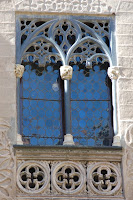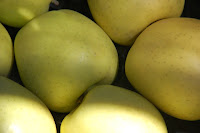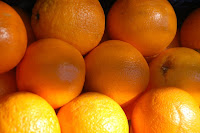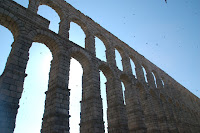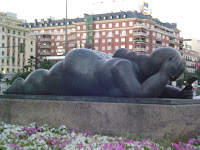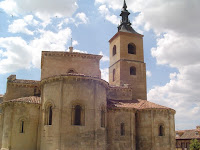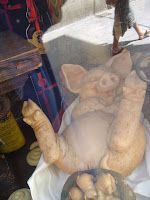 Sunday, July 15. In the afternoon, we took a tour of the bullfight ring in Madrid, which included a walk down the camino del miedo--the hallway through which the bullfighters enter the ring, knowing there is no turning back--and even out into the arena itself. We took turns taking one another’s photos wearing the capes. None of this knowledge quite prepared me for the bullfight that night.
Sunday, July 15. In the afternoon, we took a tour of the bullfight ring in Madrid, which included a walk down the camino del miedo--the hallway through which the bullfighters enter the ring, knowing there is no turning back--and even out into the arena itself. We took turns taking one another’s photos wearing the capes. None of this knowledge quite prepared me for the bullfight that night.We had tickets in the “sol y sombra” section, which turned out to be about three rows from ground, and not exactly a row of seats, but the edge of the concrete walkway on the lowest level. So, people passed behind us (but only between fights, as no one can enter after a fight has begun.) We watched the bullfight at eye level, although most of the action took place across the ring, in front of the section decorated with fancy embroidered capes.
Before the first bull entered the ring, the men all came out in procession,
 officials and those who would fight that night. The crowd cheered, and we admired their beautiful garments, the traje de los luces, suit of lights. We would get a close look at them, as they waited in the corredor right in front of us, much to the delight of some young women on the bottom row. They were like rock stars, aware of the crowd behind them, turning to smile for a photo or to take a note from some young woman. They did not seem tense, but I think they were not the matadors, who were somewhere backstage and would only enter at the dramatic moment before/for the kill.
officials and those who would fight that night. The crowd cheered, and we admired their beautiful garments, the traje de los luces, suit of lights. We would get a close look at them, as they waited in the corredor right in front of us, much to the delight of some young women on the bottom row. They were like rock stars, aware of the crowd behind them, turning to smile for a photo or to take a note from some young woman. They did not seem tense, but I think they were not the matadors, who were somewhere backstage and would only enter at the dramatic moment before/for the kill.As the players enter the arena, there would be a flare of trumpets and drums, the familiar music we associate with the bullfight. But throughout the fight itself, the only noise is that of the crowd and whatever sounds arise, unamplified, from within the arena. The bull might snort or bellow; you might hear the men talking t
 o one another as they maneuver him.
o one another as they maneuver him.The first bull to enter the ring was black, jet black, and bounded about with strength and s
 pirit, as if he had been waiting to perform for us, to gather our awe. A green ribbon, a marker for the cross between his shoulders, tossed as
pirit, as if he had been waiting to perform for us, to gather our awe. A green ribbon, a marker for the cross between his shoulders, tossed as  he ran toward one fuschia cape, the capote de brega, teased by a torredor, to another. Their job is to tire him, it seems, with one run at the sweeping capes after another.
he ran toward one fuschia cape, the capote de brega, teased by a torredor, to another. Their job is to tire him, it seems, with one run at the sweeping capes after another.Next came the picadors on horseback, the horses b
 lindfolded and caparisoned in gold. The torredors drew the bull over to the mounted picador, who then plunged his lance, the pica, down between the bull’s shoulders. It was the first act of violence against the bull, and more shocking than I can describe. After this, everything seemed quite unreal, almost dreamlike.
lindfolded and caparisoned in gold. The torredors drew the bull over to the mounted picador, who then plunged his lance, the pica, down between the bull’s shoulders. It was the first act of violence against the bull, and more shocking than I can describe. After this, everything seemed quite unreal, almost dreamlike.The bull charged the horse and seemed to have gored it, as blood stained the caparison. But, we were told on the tour that the horses are armored under the fancy drape and rarely are they hurt badly. The blood, I presume, belonged to the bull, and not the horse, who seemed to remain relatively calm, as the torredors maneuvered the bull again.
After the picadors came the banderilleros, with short spears or long darts decorated with brightly colored ruffled paper. They danced about like big birds of prey, holding the darts high like mocking horns, a
 nd when the bull came near, they drove the darts down into his shoulders, so that the bright paper shafts dangled from his back as he ran in fury and pain. Only after he had been embellished with the banderillas, stabbed with the picas, and teased to fatigue by the torredors did the matador enter the ring.
nd when the bull came near, they drove the darts down into his shoulders, so that the bright paper shafts dangled from his back as he ran in fury and pain. Only after he had been embellished with the banderillas, stabbed with the picas, and teased to fatigue by the torredors did the matador enter the ring.And set his hat down in the sand, and bow to the box where royalty or those overseeing the bullfight sat. Then began the dance with the muleta, the short red cape with a thin silver sword hidden beneath, the matador drawing the bull close and sweeping the red cape across the animal’s back, his horns, near the matador’s own body. Sometimes the matad
 or would turn his back and walk a short distance as if unconcerned. He would sidle up to the bull, mo
or would turn his back and walk a short distance as if unconcerned. He would sidle up to the bull, mo ving his feet like a girl edging toward a favor. All of his moves were careful and elegant and precise—poised. Finally, at some point that only he must know, he drew the sword and plunged it into the bull’s back, at the point marked by the cross. It would be a second sword that would kill the bull. He would crumple to the ground, turn on his side, his legs stiff out, his horn in the dirt. A team of horses came out to drag his body out of the ring.
ving his feet like a girl edging toward a favor. All of his moves were careful and elegant and precise—poised. Finally, at some point that only he must know, he drew the sword and plunged it into the bull’s back, at the point marked by the cross. It would be a second sword that would kill the bull. He would crumple to the ground, turn on his side, his legs stiff out, his horn in the dirt. A team of horses came out to drag his body out of the ring.
Only at the first bullfight did the crowd wave white handkerchiefs. This must have been the most exciting, the most dangerous, the most impressive show of courage, but the subtle differences that distinguished one ritual death from another were lost on me. There were five more bullfights—six bulls killed in all. (We were told that the meat goes to local restaurants and nothing is wasted--though there seemed to be some doubt among the American spectators who had heard different stories.) My friend Tawny left after the first one, disturbed by the violence, but Brenda and I stayed. I can’t explain why I stayed, except for a peculiar fascination that seemed to overtake me, that kept me watching and photographing the ritual before me, each time, like a dance, like a mass, like something metaphysical, not real. They say the bullfight is sex and death and life and religion, all of it. It is just so bewitching and that is part of what makes it disturbing. I don’t think I would go to see another, but I have witnessed it.
Richard Wright, in Pagan Spain, has a clear, journalistic description of a bullfight in which he also notes the spell of the drama. The bullfight he saw in 1957 must have been ordered differently than the ones we watched, as he has the picadors come in before the torredors, but otherwise the description matched what I witnessed 50 years later. The book itself seems flawed by the author’s relative lack of familiarity with the language and culture of Spain; that is, it is a traveler’s account, but Wright hardly acknowledges that perspective. Perhaps that, too, is a difference in times. In a postcolonial age, in a time when global travel is a part of many people’s life experiences, the difference between deep inner knowledge of a culture and the observations and experiences of the visitor are more striking to us. My poem on the bullfight is “To Dance in a Culture of Death, o una Americana mirando la corrida del torros del Sol y Sombra en Madrid.”

On Wednesday evening, Peter Thompson escorted us to Casa Patas, to see live flamenco, an authentic performance. The table he had reserved touched the right edge of the stage, so th
 e feet of the musicians and dancers were at our eye level and near enough that we could have touched their hems. Before the performance began, the musicians rehearsed in a corner among the tables while we chatt
e feet of the musicians and dancers were at our eye level and near enough that we could have touched their hems. Before the performance began, the musicians rehearsed in a corner among the tables while we chatt ed over wine and sangria. As the lights lowered to near dark, they entered the stage and sat in straight-back wooden chairs, the two singers in the v, flanked by guitarists and, beside us, the player of the cajon, a percussion instrument like a wooden box played with the hands. The men’s voices have a texture like instruments played with a bow, raspy and resonant. The music is percussive and loud, strummed guitars, tapped on the body, the rattle and beat of the cajon. The sound is familiar from the popular Gypsy Kings or Strom and Farrar, but the live music has a different, earthy quality to it, something you can taste.
ed over wine and sangria. As the lights lowered to near dark, they entered the stage and sat in straight-back wooden chairs, the two singers in the v, flanked by guitarists and, beside us, the player of the cajon, a percussion instrument like a wooden box played with the hands. The men’s voices have a texture like instruments played with a bow, raspy and resonant. The music is percussive and loud, strummed guitars, tapped on the body, the rattle and beat of the cajon. The sound is familiar from the popular Gypsy Kings or Strom and Farrar, but the live music has a different, earthy quality to it, something you can taste.The first dancer to enter was a young man dressed all in black, with hair curling to his shoulders. At first his heels tapped slowly, in a move like the bullfighter’s. As he warmed to the dance, though, his feet and lower legs moved so quickly and with such agility that they were at times a blur, the movement imperceptible to the eye, but captured clear on the wing in the ear. At the peak of the performance, glistening drops of sweat flew like a silver halo around his head.
Two different male dancers performed, each dancer solo with the musicians (and sometimes the musicians without the dancers.) It was the female dancer, though, who captivated the audience. She wore a dress of peacock blue, its ruffled hem sweeping the floor, the bodice and waist fitted like a second skin. Her hands curled with an elegant quietude above the rhythm her feet tapped. Not tapped, but not pounded, either. I don’t know if there is a verb for that movement and sound and emotion. The bullfight has the horror of death to it, but flamenco, equally captivating, seems pure life. This, I would return to.
